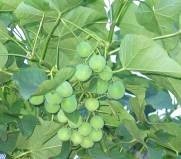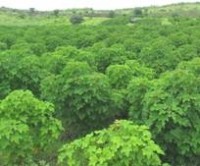Special Edition: Future Feeds
Jatropha kernel meal offers protein promise

Fishmeal, prized for use in aquaculture and monogastric diets due its high digestibility and protein levels, is a limited and costly resource. And soybean meal, currently the most commonly used plant protein source in animal feeds because of its reliable supply, high protein content and high concentration of essential amino acids, competes with human food.
Hence, there is a need to identify other protein-rich resources that could be used in animal and fish diets.
Harinder Makkar, livestock production officer at the UN’s Food and Agriculture Organization (FAO), has been looking at the possibility of raising animals and fish on alternative feeds in the tropics and subtropics, and is drawing attention to the potential the non-toxic genotype of the plant, Jatropha curcas, offers as a new protein source.
He outlined its advantages in an interview this week with FeedNavigator.
Fishmeal replacement
“On hearing jatropha (J. curcas) two things come to mind: It is an oil plant and its seeds are toxic. However, a non-toxic genotype of J. curcas exists in Mexico. Its seeds are consumed by people after roasting. Kernels from this non-toxic jatropha are also used in a number of dishes in Mexico.
Studies have shown, when phytase is added to diets, heat treated Jatropha kernel meal from the non-toxic jatropha can replace 50% of fishmeal in the diets of carp without compromising their growth performance and nutrient utilization,” he said.
A study at the University of Hohenheim in Germany showed the non-toxic jatropha seeds do not possess the main toxic agent, phorbol ester, which is present in the toxic variety.
The amino acid composition of Jatropha kernel meal and soymeal is similar except for lysine, and the sulphur-containing amino acids, cystine and methionine, which are lower and higher respectively in the jatropha kernel meal, said Makkar.
However, the phytate level in Jatropha kernel meal is 9%, or around three times higher than soymeal on a weight basis, so there is a need to supplement monogastric diets with a higher level of phytase, he added.
And the seeds of the non-toxic Jatropha contain curcin and trypsin inhibitors. But Makkar says both antinutrients are heat labile and can be destroyed by heat treatment.
He says trials evaluating the use of Jatropha kernel meal from the non-toxic genotype in pigs and poultry diets have, as yet, not been undertaken. Nevertheless, studies have been conducted on rats, showing the innocuous nature of the kernel meal, added the FAO officer.
Seed development
Breeding companies have been carrying out R&D work on the non-toxic J. curcas seeds, trying to improve their potential. Cultivation practices are also being optimized.
“Trials by seed developers in tropical regions such as Paraguay, Cameroon, Mexico and Madagascar are generating yields of around 2.5 tons of seeds per hectare, which compares favorably with soybean yields,” said Makkar.
In most developing countries, yield of soybean varies from 1 to 1.5 tons per hectare.
“Taking an average of 1.25 ton of soybean per hectare, the yield per hectare of protein and oil would be 438kg and 224kg respectively.
If we take 2.5 tons of Jatropha seeds grown on the same quality soil as soy with the same inputs, they will generate 833kg of shells which are rich in lignin and hence have high energy value so they can be used as fuel.
The remaining 1.67 tons of kernels will give 1 ton of oil, and 670kg of kernel meal containing 64% crude protein or 428kg of crude protein per hectare.
So non-toxic Jatropha would have comparable protein yield per hectare than soybean but an oil yield four times higher – this oil could be used in animal diets but also has potential for use in the food industry,” said Makkar.
However, he points out that solvent treatment or enzyme-assisted techniques would be required for the oil extraction from the Jatropha kernel.
Crop cultivation
Makkar said another advantage of the non-toxic plant, J. curcas, is that it is hardy and can grow on degraded land. “This means it could be cultivated in low quality soil. The yields would not be high but, at least, a feed source could be produced on marginal land.”
But a challenge remains. “There aren’t enough seed volumes currently available to start significant crop cultivation and generate sufficient quantities of non-toxic Jatropha kernel meal and oil for feed – but breeding companies continue to invest in development of seed and their cultivation practices in the believe that a market will follow.
As it has a similar protein profile to soymeal, then, ultimately, the potential for Jatropha kernel meal as an alternative feed source will depend on its price,” said Makkar.
Biofuel interest
The biofuel industry has shown interest in the toxic genotype J. curcas, which is found in parts of tropical Central and South America and many tropical and subtropical regions of Africa and Asia.
The oil from toxic J. curcas kernels can be transformed into good quality biodiesel through transesterification and used as a substitute for diesel.
“However, to really make it appealing and economically viable as a biofuel source, that sector says the animal feed industry has to get on board, employ a detoxification method, and use the kernel meal leftover from the oil extraction in animal and fish diets,” said Makkar.
Several studies have been undertaken on detoxified J. curcas kernel meal and protein isolate in fish poultry and pigs. (1)
Detoxified J. curcas kernel meal and protein isolate have been show to replace 50 and 75% of fishmeal protein, respectively, without compromising growth performance or nutrient uptake in fish, and without adversely affecting fish health, as illustrated by blood parameter evaluation and histopathological investigations on fish organs.
Based on good growth performance, nutrient utilization and high amino acid digestibility, detoxified J. curcas kernel meal was shown to be a valuable protein source for turkeys, while also shown to replace 50% soymeal protein in the diets of growing pigs.
“J. curcas detoxification methods are costly. However, given economics of scale, the wider use of such technology could make it more affordable over time,” said Makkar.
(1) Source: Biofuel co-products as livestock feed – Opportunities and challenges











